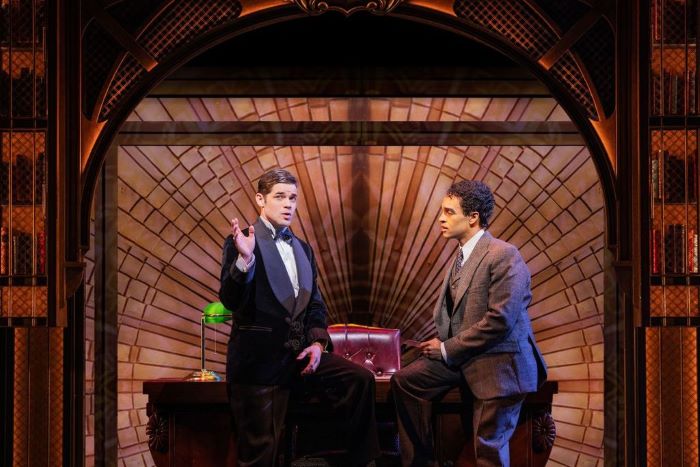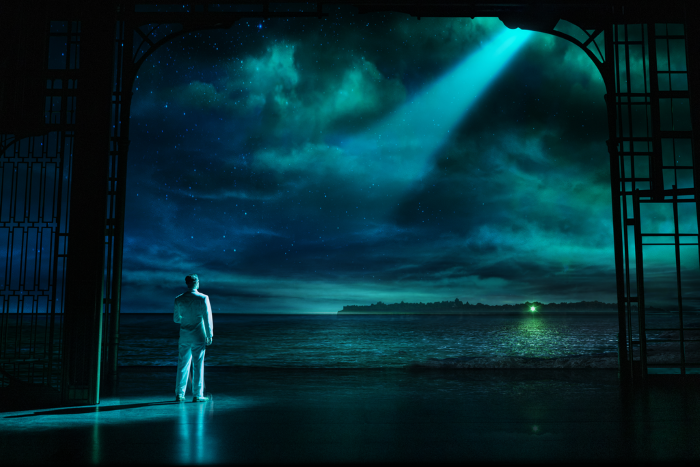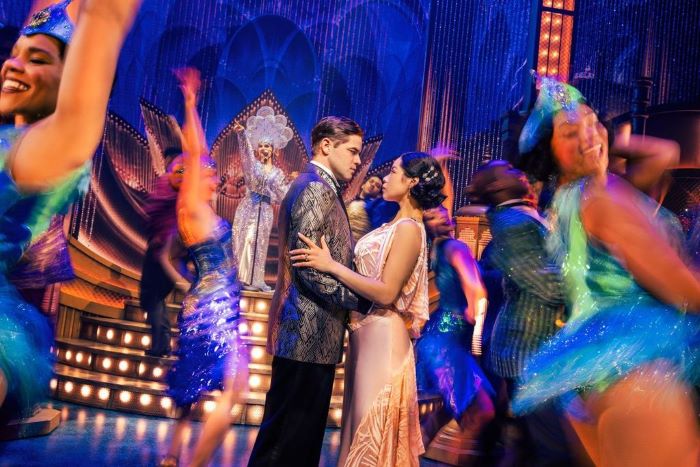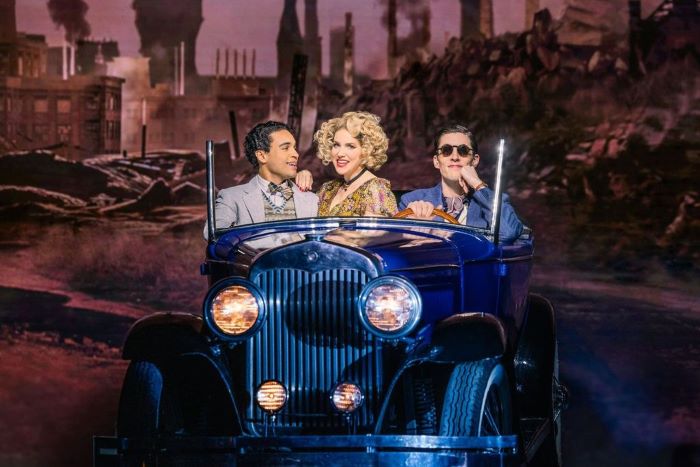One of the most popular American novels of all time, F. Scott Fitzgerald’s 1925 classic The Great Gatsby remains a perennial bestseller, translated into 42 different languages, with over 30 million copies sold worldwide, and another 500,000 continuing to sell each year. It has been the inspiration for numerous stage, screen, and radio adaptations, and now a new Broadway musical. Following a sold-out record-breaking one-month world-premiere engagement at New Jersey’s Papermill Playhouse in 2023, The Great Gatsby, with music by Jason Howland, lyrics by Nathan Tysen, and a book by Kait Kerrigan, has opened at the Broadway Theatre, in an over-the-top spectacle with glitter galore that gives the tragic story and its extravagant era of the 1920s a strangely risible tone.

Set on Long Island in the libertine Jazz Age of the Roaring Twenties, first-person narrator Nick Carraway introduces his experiences with the enigmatic self-made millionaire Jay Gatsby (by way of bootlegging) and his obsession with winning back his former girlfriend Daisy Buchanan – Nick’s cousin, wife of the wealthy and philandering Tom Buchanan, and a self-indulgent socialite who chose the security, prestige, and privilege of old money, class, and carelessness over the romance they shared and the love that drove him to his nouveau-riche lifestyle, and ultimately to his death. Sound funny? It’s not, but Kerrigan and director Marc Bruni make the characters, their pretentious behavior, and affected speech patterns (dialect coaching by Deborah Hecht) more ridiculously laughable than sad and cautionary.

A stunning (and very active) set and projections by Paul Tate dePoo III and dazzling lighting by Cory Pattak (with the iconic green light on the dock across the water at the Buchanan residence) transport us to Gatsby’s opulent Art Deco mansion and extravagant parties, designed to attract and to impress Daisy, from whom he was separated by his service in WWI, with lavish costumes by Linda Cho, hair and wigs by Charles G. LaPointe and Rachael Geier, and make-up by Ashley Ryan that recreate the sparkling decadent glamour of the Flappers and the formal attire of the affluent, which contrast with the tasteless clothes of the lower classes and stereotyped mobsters.
Along with the defining eye-popping artistic design, Dominique Kelley’s high-spirited choreography animates Howland’s more pop- than jazz-infused score – with orchestrations by Howland and Kim Scharnberg and sound by Brian Ronan – that doesn’t fully jibe with the period style.

Jeremy Jordan stars in the titular role and brings his stellar voice, extraordinary vocal range, breath control, and emotional resonance to his bravura solos (including “For Her”) and duets with Eva Noblezada as Daisy (“My Green Light”), conveying all the longing and commitment that motivate his character and expressing the joy of their reunion. Noah J. Ricketts as Nick delivers affecting passages of Fitzgerald’s prose, and Samantha Pauly as Jordan Baker, Daisy’s friend and pro golfer with an aversion to marriage, also contributes some impressive vocals. But their characterizations, as written by Kerrigan and directed by Bruni, don’t draw us into the lure of money and pleasure in excess that is central to Fitzgerald’s serious plot, its pessimistic view of inherited upper-class entitlement, and grave cynicism towards the attainability of the American Dream for those who weren’t born into it. Overall, there’s a lot of flash and little substance to generate any sympathy.

Many of the scenes even take on a comedic vaudevillian quality – among them, the arranged meeting of prospective lovers Gatsby and Daisy, and Nick and Jordan, at an overly sumptuous tea party at Nick’s cottage, where the men are given to panic attacks and the women make the sexual advances. And the other featured figures seem like little more than one-note caricatures. Daisy’s husband Tom (played by John Zdrojeski) is a brutal and egomaniacal villain, and his low-class lover Myrtle Wilson (Sara Chase) is unrefined and brazen, as portrayed in the exaggerated scene of their assignation, to which Nick is unexpectedly a witness. Rounding out the featured cast are Paul Whitty as Myrtle’s downtrodden husband George, whose menial demeanor suddenly explodes and causes a splash (literally), and Eric Anderson as Wolfsheim, a cookie-cutter mobster who sings a vibrato-heavy “Shady,” backed by men in swirling black coats.
While some might find the elaborate production a feast for the eyes and ears, for purists who believe that classics are classic for a reason and authentic period pieces don’t need an updated perspective, this musical version of The Great Gatsby is one that you might want to skip. And now that the novel, as of January 1, has become public domain, you can expect an array of new productions, some of which might be more faithfully in tune with the mood and meaning of the original.
Running Time: Approximately two hours and 30 minutes, including an intermission.
The Great Gatsby plays through Sunday, November 24, 2024, at the Broadway Theatre, 1681 Broadway, NYC. For tickets (priced at $50-324, including fees), go online.
Sony Masterworks Broadway will release the original Broadway cast recording in digital format on June 21, and the physical CD on August 2; you can preorder it here.





